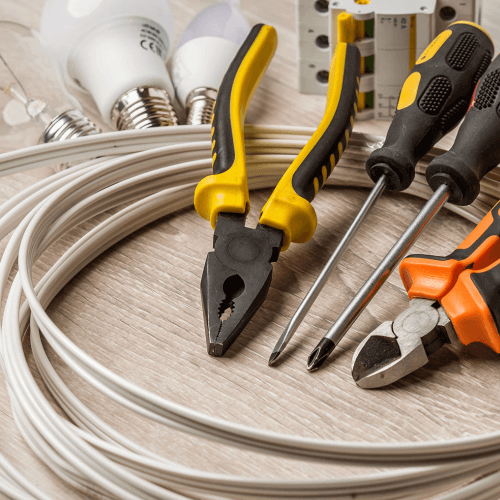
Why Choose Flat Panels from Duralec?
Flat-panel LED lights are quickly becoming the top choice for commercial construction. These lights provide countless benefits and are a huge improvement over the technology of only a decade or two ago. However, not all LED lights are alike. Understanding the options is key to choosing the right light for your application.
Benefits of Flat-panel LED Lights






Quick Definition: Flat Panels versus Troffers
Commercial spaces like offices and retail stores usually have one of two kinds of LED lights: flat panels or troffers. The flat-panel LED is fairly self-explanatory (it’s flat, it’s a panel), and the troffer light is almost as easy to define. The word “troffer” is a mashup of “trough” and “coffer.” In a troffer light, the bulbs or diodes sit in a central trough, and the light is reflected downward by a panel above them.

Flat panels and troffers usually come in similar sizes—2×2 feet, 2×4 feet, and so on—and are mounted in similar ways. Each has its benefits, and we’ll discuss troffers at a later date.
Quick Definition (#2): Edgelit versus Backlit
Flat-panel LED lights are generally manufactured in two styles: edgelit and backlit. Edgelit panels have diodes spread around the perimeter of the light. They cast their light toward the center and rely on the lens to diffuse the light in an even way. Over time, edgelit panels can create yellow centers and appear dusty or uneven. Backlit panels, on the other hand, have diodes spread across the entire face of the panel. Backlit panels provide an even light with no danger of yellow spots.
Flexible Features of Flat Panels
Flat-panel LED fixtures come in a variety of shapes, sizes, and capabilities. One thing that sets a flat panel apart from its antiquated ancestors is its array of customizable features. In short, there is a flat-panel LED light for every application out there. Let’s explore some of the specs one might find on a Duralec-provided LED light.
Wattage: The wattage rating (measured in watts, or W) refers to the power needed to run the light at its maximum level. Not long ago, you might have had a lamp in your home with a 100W incandescent bulb in it. By comparison, a flat-panel LED light fixture might only need 30W or 40W for the entire unit because LED lights use so much less electricity than your lamp. Duralec-provided IntrinsiX’s flat-panel LED fixtures offer selectable wattage on many units, including 20W, 30W, and 40W levels. This flexibility allows you to tailor your energy savings.



Speaking of power, IntrinsiX lights use high-quality drivers that are considered best-in-class. Drivers are usually the first thing to fail in an LED light, so it’s important to have the best driver possible. Duralec lights are DLC- and ETL-listed, as well, guaranteeing high quality and efficiency.
Voltage: Voltage is the amount of power running into the light fixture. It is measured in volts (V). Most fixtures run on standard 120V-277V wires, though larger lights can take advantage of a 277V-480V system. Duralec flat-panel LED fixtures run on common 120-277V inputs, making them easy to install and inexpensive to run.
Color temperature: This measurement refers to a light’s appearance—how “warm” or “cool” or “white” it appears. Its full name is color corrected temperature (CCT), and it’s measured in degrees Kelvin (K). Different applications call for different colors of light. A living room would want a warm light, which is slightly soft and almost yellow. An office or retail store would want a cool light, which is inviting but brighter than a warm light. A warehouse would want a powerful white light for optimal visibility.
Today’s leading flat-panel LED lights offer selectable CCT. For example, the IntrinsiX selectable-watt fixtures also offer selectable CCT, in 3500K, 4000K, and 5000K temperatures. This feature allows you to fine-tune your light for whatever application you need. This light also features optional dimming, for even more flexibility, comfort, and cost savings.
Brightness: The technical term for brightness is lumen output. Brightness is measured in lumens (lm), and it is a key number to look for when planning the lighting for a space. Brightness is not synonymous with wattage, because not all lights are made of the same quality.
Again, today’s best products offer selectable lumen output. The IntrinsiX flat-panel LED fixtures offer 2500lm, 3750lm, and 5000lm outputs. This flexibility guarantees that you have as much light as you need, as well as the flexibility to adapt to any changes that might happen to the space in the future.
Mounting options: Flat-panel LED lights come ready to be mounted in multiple ways. They fit into recessed ceilings with ease, giving a smooth and flush look. They can be mounted on surfaces with simple hardware. They can even be suspended by cables. IntrinsiX flat panels offer an ultra slim profile (1.77”) that works in every application.
Emergency backup: Commercial spaces need emergency battery backups for their lighting, and Duralec offers those for all of its LED light fixtures. 90 minutes of backup power guarantees the lights stay on if the power goes off.
Sensor options: Today’s buildings are getting smarter and smarter, and a key to this advancement is the use of sensors on light fixtures. Lighting controls can be attached to a variety of sensors, but, in general, they fall into two categories: those that sense motion or occupancy or those that sense daylight.
Sensors that detect motion or occupancy include microwave sensors. These emit high-frequency waves that bounce off of objects in a room. When there is a change in the return signal, the sensor knows that something (say, a person) is moving within the space. The sensor can then turn the light on. Ultrasonic sensors work in a very similar fashion.
Another sensor to detect occupancy is a passive infrared sensor (PIR). These sensitive devices detect heat coming off of objects in a space. When a person walks into a room, the PIR sensor “sees” the heat (i.e., senses the infrared radiation), and can turn a light on.
Sensors that detect daylight coming into a space—and can adjust light levels accordingly—are photocell sensors. These devices, also called ‘daylight-harvesting’ sensors, gather photons, determine their brightness level, and send instructions to the light fixtures. With these instructions, lights can either be turned on or off or even dimmed throughout the day to adjust to incoming light, keeping a consistent amount of lumens in a room.
Advanced lighting controls: Also called “networked lighting controls” or “smart light controls,” these devices are the next frontier of smart buildings, energy savings, and better lighting. Combining software with building systems—lighting, HVAC, and more—is allowing building owners to realize huge savings. For example, the ability to pre-program a building’s lighting schedule or to allow automatic adjustments to factors like sunshine or remote work has created many new opportunities for efficiency. Hooking lights up to wifi or a Bluetooth mesh opens the door to a new “smart” world.
Flat-panel LED lights and networked lighting controls are revolutionizing commercial lighting.
To learn more about Duralec lights, sensors, and controls, contact one of our experts today.



